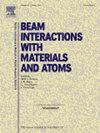Influence of implantation and annealing temperatures on the irradiation damage in He2+ ion implanted 6H-SiC
IF 1.4
3区 物理与天体物理
Q3 INSTRUMENTS & INSTRUMENTATION
Nuclear Instruments & Methods in Physics Research Section B-beam Interactions With Materials and Atoms
Pub Date : 2025-01-13
DOI:10.1016/j.nimb.2025.165611
引用次数: 0
Abstract
Single crystal 6H-SiC samples were implanted with He2+ ions to 5 × 1016 cm−2 at 400 °C and 750 °C, and the sample implanted at 400 °C was subsequently annealed at 750 °C for 3 h in vacuum. These samples were characterized using X-ray diffraction, Raman spectroscopy, UV–Visible spectrophotometry and transmission electron microscopy. The results showed that the lattice expansion, level of disorder and defect concentrations in the He-implanted 6H-SiC has decreased with increasing implantation temperature at the same dose. There was a reduced irradiation effect in the 6H-SiC irradiated at 400 °C and subsequently annealed at 750 °C compared to the sample solely irradiated at 750 °C to the same dose. This behavior was attributed to more stable defect clusters and enhanced He trapping at defects in the latter sample. Possible He bubble effects cannot be excluded. In addition, the temperature effect on defect recovery in the dynamic annealing during irradiation and post-irradiation annealing was discussed.
求助全文
约1分钟内获得全文
求助全文
来源期刊
CiteScore
2.80
自引率
7.70%
发文量
231
审稿时长
1.9 months
期刊介绍:
Section B of Nuclear Instruments and Methods in Physics Research covers all aspects of the interaction of energetic beams with atoms, molecules and aggregate forms of matter. This includes ion beam analysis and ion beam modification of materials as well as basic data of importance for these studies. Topics of general interest include: atomic collisions in solids, particle channelling, all aspects of collision cascades, the modification of materials by energetic beams, ion implantation, irradiation - induced changes in materials, the physics and chemistry of beam interactions and the analysis of materials by all forms of energetic radiation. Modification by ion, laser and electron beams for the study of electronic materials, metals, ceramics, insulators, polymers and other important and new materials systems are included. Related studies, such as the application of ion beam analysis to biological, archaeological and geological samples as well as applications to solve problems in planetary science are also welcome. Energetic beams of interest include atomic and molecular ions, neutrons, positrons and muons, plasmas directed at surfaces, electron and photon beams, including laser treated surfaces and studies of solids by photon radiation from rotating anodes, synchrotrons, etc. In addition, the interaction between various forms of radiation and radiation-induced deposition processes are relevant.

 求助内容:
求助内容: 应助结果提醒方式:
应助结果提醒方式:


